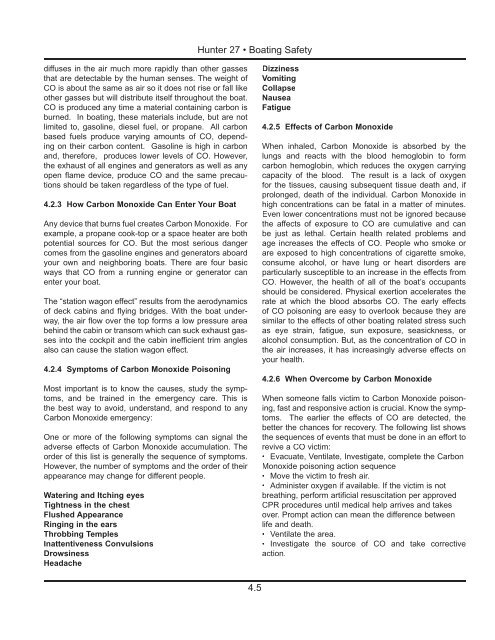27 Operator's Manual.. - Marlow-Hunter, LLC
27 Operator's Manual.. - Marlow-Hunter, LLC
27 Operator's Manual.. - Marlow-Hunter, LLC
Create successful ePaper yourself
Turn your PDF publications into a flip-book with our unique Google optimized e-Paper software.
<strong>Hunter</strong> <strong>27</strong> • Boating Safety<br />
diffuses in the air much more rapidly than other gasses<br />
that are detectable by the human senses. The weight of<br />
CO is about the same as air so it does not rise or fall like<br />
other gasses but will distribute itself throughout the boat.<br />
CO is produced any time a material containing carbon is<br />
burned. In boating, these materials include, but are not<br />
limited to, gasoline, diesel fuel, or propane. All carbon<br />
based fuels produce varying amounts of CO, depending<br />
on their carbon content. Gasoline is high in carbon<br />
and, therefore, produces lower levels of CO. However,<br />
the exhaust of all engines and generators as well as any<br />
open flame device, produce CO and the same precautions<br />
should be taken regardless of the type of fuel.<br />
4.2.3 How Carbon Monoxide Can Enter Your Boat<br />
Any device that burns fuel creates Carbon Monoxide. For<br />
example, a propane cook-top or a space heater are both<br />
potential sources for CO. But the most serious danger<br />
comes from the gasoline engines and generators aboard<br />
your own and neighboring boats. There are four basic<br />
ways that CO from a running engine or generator can<br />
enter your boat.<br />
The “station wagon effect” results from the aerodynamics<br />
of deck cabins and flying bridges. With the boat underway,<br />
the air flow over the top forms a low pressure area<br />
behind the cabin or transom which can suck exhaust gasses<br />
into the cockpit and the cabin inefficient trim angles<br />
also can cause the station wagon effect.<br />
4.2.4 Symptoms of Carbon Monoxide Poisoning<br />
Most important is to know the causes, study the symptoms,<br />
and be trained in the emergency care. This is<br />
the best way to avoid, understand, and respond to any<br />
Carbon Monoxide emergency:<br />
One or more of the following symptoms can signal the<br />
adverse effects of Carbon Monoxide accumulation. The<br />
order of this list is generally the sequence of symptoms.<br />
However, the number of symptoms and the order of their<br />
appearance may change for different people.<br />
Watering and Itching eyes<br />
Tightness in the chest<br />
Flushed Appearance<br />
Ringing in the ears<br />
Throbbing Temples<br />
Inattentiveness Convulsions<br />
Drowsiness<br />
Headache<br />
Dizziness<br />
Vomiting<br />
Collapse<br />
Nausea<br />
Fatigue<br />
4.2.5 Effects of Carbon Monoxide<br />
When inhaled, Carbon Monoxide is absorbed by the<br />
lungs and reacts with the blood hemoglobin to form<br />
carbon hemoglobin, which reduces the oxygen carrying<br />
capacity of the blood. The result is a lack of oxygen<br />
for the tissues, causing subsequent tissue death and, if<br />
prolonged, death of the individual. Carbon Monoxide in<br />
high concentrations can be fatal in a matter of minutes.<br />
Even lower concentrations must not be ignored because<br />
the affects of exposure to CO are cumulative and can<br />
be just as lethal. Certain health related problems and<br />
age increases the effects of CO. People who smoke or<br />
are exposed to high concentrations of cigarette smoke,<br />
consume alcohol, or have lung or heart disorders are<br />
particularly susceptible to an increase in the effects from<br />
CO. However, the health of all of the boat’s occupants<br />
should be considered. Physical exertion accelerates the<br />
rate at which the blood absorbs CO. The early effects<br />
of CO poisoning are easy to overlook because they are<br />
similar to the effects of other boating related stress such<br />
as eye strain, fatigue, sun exposure, seasickness, or<br />
alcohol consumption. But, as the concentration of CO in<br />
the air increases, it has increasingly adverse effects on<br />
your health.<br />
4.2.6 When Overcome by Carbon Monoxide<br />
When someone falls victim to Carbon Monoxide poisoning,<br />
fast and responsive action is crucial. Know the symptoms.<br />
The earlier the effects of CO are detected, the<br />
better the chances for recovery. The following list shows<br />
the sequences of events that must be done in an effort to<br />
revive a CO victim:<br />
• Evacuate, Ventilate, Investigate, complete the Carbon<br />
Monoxide poisoning action sequence<br />
• Move the victim to fresh air.<br />
• Administer oxygen if available. If the victim is not<br />
breathing, perform artificial resuscitation per approved<br />
CPR procedures until medical help arrives and takes<br />
over. Prompt action can mean the difference between<br />
life and death.<br />
•<br />
•<br />
action.<br />
Ventilate the area.<br />
Investigate the source of CO and take corrective<br />
4.5

















